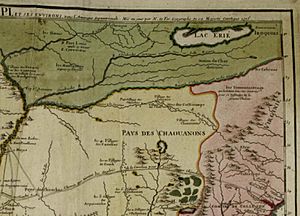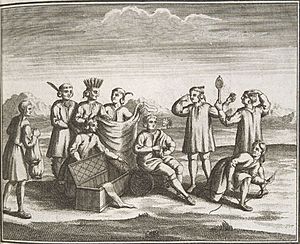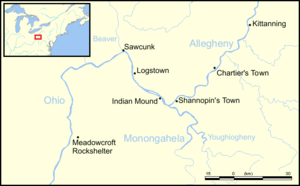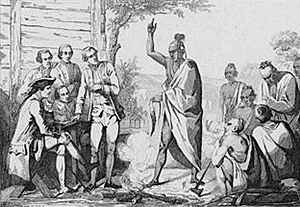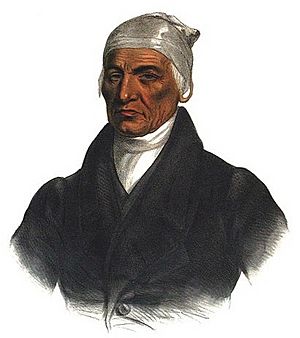Peter Chartier facts for kids
Quick facts for kids
Peter Chartier
|
|
|---|---|
| Born |
Pierre Chartier, Shawnee: Wacanackshina (White One Who Reclines)
1690 |
| Died | 1759 (aged 69) |
| Known for | Promoting Native American civil rights, early Temperance movement |
| Spouse(s) | Blanceneige-Wapakonee Opessa (1695–1737) |
| Children | François, René and Anna Chartier |
| Parent(s) | Martin Chartier (1655–1718); Sewatha Straight Tail (1660–1759) |
Peter Chartier (1690–1759) was a fur trader who was part Shawnee and part French. His original name was Pierre Chartier. He could speak many languages.
Later, he became a leader and a chief among the Pekowi Shawnee people. He was one of the first people to speak up for Native American civil rights. He worked with other chiefs to stop the sale of alcohol in Native American communities in Pennsylvania.
Because of disagreements with the English government, he joined the French in 1745. He left Pennsylvania with his group of over 400 Pekowi Shawnee. For four years, they traveled through parts of what are now Ohio, Kentucky, Alabama, and Tennessee.
He and his people eventually settled in Illinois, near a French town. Peter Chartier and some of his warriors later fought alongside the French against the English during the French and Indian War.
Many places are named after Chartier. These include towns like Chartiers Township and Chartiers (Pittsburgh). Rivers like Chartiers Creek and Chartiers Run (Allegheny River tributary) are also named for him.
Contents
Peter Chartier's Early Life
Peter Chartier was born Pierre Chartier in 1690. His mother was a Shawnee woman, and his father was a French colonist named Martin Chartier. Martin was born in France and moved to Quebec (New France) in 1667.
In 1674, Martin traveled to Illinois. There, he met Sewatha Straight Tail, a daughter of a Pekowi Shawnee chief. They married in a Shawnee ceremony in 1675.
Pierre was born in 1690 in Tennessee, near where Nashville is today. His father ran a trading post there. His mother gave him the Shawnee name Wacanackshina, which means "White one who reclines." Around 1697, his family moved to Pennsylvania.
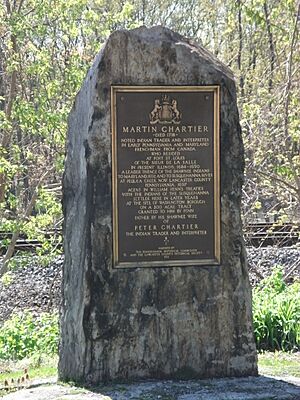
Around 1710, Pierre Chartier married his cousin, Blanceneige-Wapakonee Opessa. They had three children: François, René, and Anna.
In 1717, William Penn gave Martin Chartier land in Pennsylvania. Martin and Pierre started a trading post there. In 1718, they moved again, and Martin Chartier died that April.
After his father's death, a powerful man named James Logan took Martin Chartier's land. Logan said Martin owed him money. Logan made Peter Chartier and his family leave the property. He also forced a group of Conestoga people living there to leave.
Peter Chartier's Trading Career
Logan allowed Peter Chartier to keep his trading post on the land as a renter. Chartier later opened another trading post in Paxtang, Pennsylvania. Even though Chartier became wealthy, his experience with Logan made him angry. This was one reason he turned against the government.
In 1730, Peter Chartier got a license to trade with Native Americans in southwestern Pennsylvania. By 1732, Chartier was well-known as a negotiator. He spoke Shawnee, French, and English.
A Quaker trader named Edmund Cartlidge wrote that Chartier was "well inclined" and helpful. He said Chartier spoke "Shawnise Tongue very perfect" and could do "a great deal of good."
In 1732, Chartier helped as an interpreter at a meeting in Philadelphia. Shawnee chiefs met with the Governor of Pennsylvania and other leaders.
Disagreements with the Government
Efforts to Control Alcohol Sales
In 1733, Shawnee chiefs complained to the Governor. They said that many traders were bringing rum into their communities without permission. They asked for permission to destroy the rum barrels.
In 1734, several Shawnee chiefs wrote a letter. They listed traders who were causing problems. Chartier was listed as a good trader. The chiefs said he was "one of us" and could bring as much rum as he wanted. But they warned that they would destroy rum barrels and seize goods from other traders. The Shawnee wanted to control rum sales to reduce problems.
Stopping Rum in Shawnee Towns
By 1737, Chartier became a chief of the Pekowi Turtle Clan. He decided to stop the sale of rum in Shawnee communities in his area. He convinced other chiefs to do the same.
Chartier and 98 Shawnee signed an agreement. They promised to spill all rum and appoint men to stop alcohol from entering their towns for four years. Governor Patrick Gordon was not happy about this. Traders kept bringing rum into Shawnee communities, even those the Shawnee had banned.
The French government wanted to gain the support of Native American groups. In 1740, the Governor of New France invited Chartier and other Shawnee leaders to meet in Montreal. They wanted to discuss moving to Detroit, which was under French control, and forming an alliance. Chartier declined the invitation.
Tensions grew with the Pennsylvania government in 1743. The governor believed Chartier's Shawnee background made him difficult. He thought Chartier would cause trouble.
In 1743, Chartier moved to Shannopin's Town. He set up a trading post on the Allegheny River. This place became known as Chartier's Town.
Chartier Leaves Pennsylvania in 1745
Chartier was frustrated with the rum trade issue. In April 1745, he accepted a military role from the French. He left his settlement with about 400 Pekowi Shawnee and headed southwest.
In July 1745, traders claimed Chartier had robbed them on the Allegheny River. They said he had a captain's commission from the King of France. Chartier's land in Pennsylvania was taken by the government.
Chartier led his Shawnee group to Logstown. He tried to convince Chief Kakowatcheky to join him, but the chief refused. Chartier and his people then went to Lower Shawneetown. They knew they had to leave Pennsylvania because it was under British control.
In June, a Frenchman visited Lower Shawneetown. He saw Chartier trying to convince the leaders there to join the French. But they refused, saying they did not want to be "slaves" to the French.
The Shawnee were used to moving. On June 24, 1745, the group left Lower Shawneetown. They traveled down the Ohio River to Kentucky. Some historians believe they established a new community called Eskippakithiki.
Fighting with other tribes and an outbreak of smallpox caused them to move south in 1748. They founded a village near what is now Sylacauga, Alabama. Black Hoof, who later became a chief, was a child with this group and remembered the journey.
The Pennsylvania government continued to offer a reward for Chartier as late as 1747.
Meeting in Detroit in 1747
Chartier went to Detroit in 1747 to meet with a French leader. He explained why his Shawnee group did not move to Detroit. The French had hoped to get many Shawnee and other tribes to join them. But Chartier and only a few other Shawnee leaders accepted French support.
Chartier's group preferred to settle on the Wabash River. Chartier wanted to keep his people independent, not fully under French or English control.
Chartier's Group Divides in 1748
Chartier's Shawnee group split up several times. Some stayed in Lower Shawneetown. In the summer of 1748, over a hundred, led by Chartier's cousin, returned to Pennsylvania.
Chartier's decision to join the French worried the British. The Pennsylvania government feared other tribes would become French allies. The government asked the returning Shawnee to admit their mistake and promise to be loyal. Chartier's cousin apologized for joining Chartier.
Moving to Illinois
Chartier and about 270 Shawnee left Alabama and moved to French Lick in Tennessee, where Chartier was born. They stayed there until fighting with the Chickasaw tribe forced them to leave.
The group, now about 190 people, traveled down the Cumberland River. They then entered the Ohio River. They found it hard to travel upstream, so they stopped near what is now Old Shawneetown, Illinois. French traders and Kaskaskia Native Americans invited them to settle near Kaskaskia, Illinois.
In 1750, problems arose between the Shawnee and the local tribes. Fighting broke out until Chartier signed a peace treaty in Mobile, Alabama.
Chartier told the French leader that his entire nation was loyal to the French. This was important as the French prepared for war.
Fighting in the French and Indian War
The French and Indian War was a big conflict between Britain and France in North America. In June 1754, Chartier, his Shawnee warriors, and his two sons, François and René, were present at a battle where a French captain was killed.
In July 1754, he and his sons helped the French win against George Washington at the Battle of Fort Necessity. Both of Chartier's sons fought against the British in many battles during the French and Indian War.
Peter Chartier's Death
Peter Chartier was last seen in 1758 in a village on the Wabash River. There is some evidence that Chartier died in a smallpox outbreak that started in 1757. This disease spread through Native American communities across North America.
Peter Chartier's Legacy
Peter Chartier as an Interpreter
Early in his life, Peter Chartier was a skilled go-between. He helped bridge the gap between the English and the Native American tribes. He was an interpreter and negotiator. He played a key role in keeping good relations, forming military alliances, and promoting trade.
Many other traders of mixed Native American and French heritage also served in this role. They often spoke English, French, and several Native American languages. They understood both European and Native American customs.
Controlling Alcohol Sales
Chartier's decision to join the French and lead his community out of Pennsylvania caused fear among the British. They worried that Native Americans would attack British settlements.
Because of this, the Pennsylvania government finally tried to control the rum trade. In 1745, after Chartier left, the Lieutenant-Governor issued a statement. It said that Native Americans had complained about problems caused by strong alcohol.
The government made the law against selling rum in Native American communities stronger. They doubled the fine and required traders to pay a bond. They also gave Native Americans the power to break barrels of rum if it was sold illegally. However, this law was not always strictly followed.
Native American Independence
Historian Stephen Warren describes Peter Chartier as a bold example of independence. He says Chartier made both the English and French angry.
Warren believes Chartier encouraged different Native American groups to unite. He also argues that both Peter and his father Martin Chartier influenced the Shawnee's views. The Shawnee, like the Chartiers, refused to give in to French, English, or Iroquois control. They made their own choices based on their lives and needs.
|


